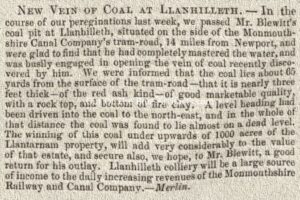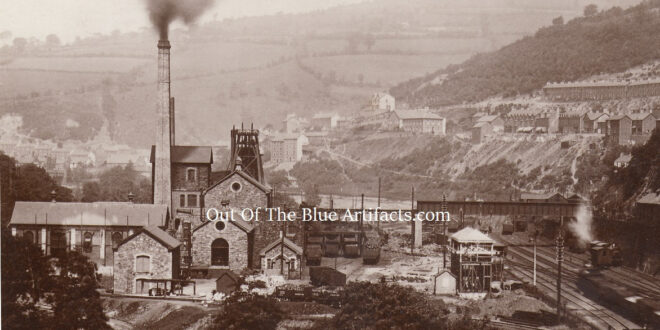Llanhilleth Collieries – A Brief History.
 Mr Reginald James Blewitt M.P.
Mr Reginald James Blewitt M.P.
In 1846-1847 Mr Reginald James Blewitt opened the Old Llanhilleth Colliery situated on the eastern side of the valley at Llanhilleth, a report of which can be seen in the 1849 article (left) from the Monmouthshire Merlin newspaper. Under the direction of Mr Blewitt, a shaft 180′ feet in depth was sunk to the House-Coal coal seam.
Adcock’s Spray Pump.
On Wednesday 21st of July 1847, Mr R. J. Blewitt held a test and exhibition of a new pump at his colliery in Llanhilleth. The pump known as the Adcock’s Spray Pump, was designed and built by Mr Henry Adcock C.E. an engineer from Birmingham. It was used to pump water from mine shafts and tunnels in the progress of being driven or sunk. It was reported that many eminent people from all over the coalfield attended the exhibition. After its sinking it is unclear as to whether Mr Blewitt began some sort of coal production.
The Sale of the Colliery.
On Thursday 20th of May 1858, the Llanhilleth Colliery was for sale, the Monmouthshire Merlin newspaper advertised its sale as containing valuable colliery machinery and plant consisting of powerful engines, boilers, pumping and winding gear, pipes plant and castings etc. Over the next few years, the colliery was advertised for sale and also to let.
Mr Walter Powell.
In 1872 Mr Walter Powell of Messrs Henry and Walter Powell colliery proprietors purchased the Llanhilleth Colliery from Mr Reginald James Blewitt.
The Messrs Powell Connection and Question of Ownership.
It was a little unclear as to who actually financially funded the purchase of the Llanhilleth Colliery at this time as most newspapers reported that Mr Walter Powell of Messrs Henry and Walter Powell colliery proprietors purchased the colliery, although in the history of the colliery by Mr Edward Jones (as seen below) he states – “The pit was purchased from Mr Reginald James Blewitt by Mr Powell of the Gaer, Newport, the colliery later passing into the hands of his son Mr Walter Powell”. Mr Thomas Powell the head of the Powell Duffryn Company had died on 24th of March 1863, long before the purchase, so it is unclear as to whether he meant the company of Messrs Powell Duffryn funded the purchase in the name of Powell Bros.
In the December of 1872 the chimney stack at the Woodfield Colliery, Blackwood, which at the time was the tallest stack that had ever been erected in South Wales was demolished. Messrs Powell Bros purchased the bricks, over 100,000 of them from the stack and also the engine house which was to be utilised at the new colliery at Llanhilleth.
The New Sinking by Mr Powell.
In the 1870’s Mr Walter Powell of Messrs Henry and Walter Powell colliery proprietors started sinking another shaft (the new pit) on the site. The shaft was sunk to the depth of 240′ feet with a powerful winding engine on site, maybe from the equipment purchased from the Woodfield Colliery?
The Sale of the Colliery.
In November 1883, two years after the death of Mr Walter Powell the collieries were put up for sale. It seems as though, the same as Mr Blewitt, the company encountered problems in establishing a productive colliery at Llanhilleth.
Messrs Partridge Jones & Co Ltd.
In 1889 Messrs Partridge Jones & Co Ltd announced they were to purchase Llanhilleth Colliery and had plans to open four other collieries in the Llanhilleth area.
The New Sinkings at the Colliery.
After the purchase of the collieries new pits were sunk under the direction of Messrs Partridge Jones & Co Ltd.
The Completion of the New Sinkings.
On Saturday 15th of October 1892, the South Wales Daily Newspaper reported on the recent dinner held by Messrs Partridge Jones and Co Ltd at the Royal Oak Hotel, Llanhilleth. The event being in connection with the completion of sinking operations and finding the celebrated black vein steam coal seam at their No2 pit, Llanhilleth. Amongst those present were as follows – Mr Edward Jones (Managing Director); Mr J. E. Ward (Legal Representative); Mr W. Davies (Manager); Mr F. A. A. Smith (Secretary of Messrs Partridge Jones and Co Ltd); Mr W. Gay (Under-Manager); Mr J. Turner (Mechanic); Mr J. Morgan of Blaensychan; Mr W. Hughes of Llanerch; Mr D. Lougher (Mining Engineer) of Pontypool; Mr W. H. Davies of Pontypool Tinplate Works; Mr D. S. Davies of Abersychan; Mr Phillips of Maesycnew; Mr D. Jenkins M.E., of Newbridge; Mr Morris and Mr P. Phillips of Newport; Mr R. W. Grant of Abersychan; Mr T. Morgan of Aberbeeg; Mr Evans G.W.R., Aberbeeg; Mr Lidster, Crumlin High Level; Mr R. J. Steward, Crumlin Low Level and 120 employees of the company:
After the dinner and toasts, Mr Edward Jones occupied the chair, he proposed “Success to the Llanhilleth Collieries” and gave a brief history of the Llanhilleth Collieries, Mr Jones stated – “Operations first commenced on the House Coal seam by the late Mr Blewitt and afterwards by Mr Powell of the Gaer and again passing into the hands of his son Mr Walter Powell. It had not been a successful undertaking on the part of these people and it was considered a bold step when Messrs Partridge Jones and Co Ltd took the old pits and determined to sink to the steam coal measures. This happened three and a half years ago and in consequence of the great advance in wages and commodities the estimated cost of carrying out the work had been greatly exceeded, but still today they were able to rejoice upon the completion of the gigantic undertaking”. A splendid seam of coal had been found, sufficient to afford a large output and find employment for their day and for their children’s too”.
Mr Jones was profoundly thankful that the whole of this dangerous undertaking of sinking the pits had been carried out without the loss of a single life, which spoke volumes for the care and attention of those entrusted with the carrying out the work. He said that he trusted that the men engaged in getting the coal would do their part and assured them nothing should be wanting upon the part of the company to establish its reputation upon the market.
The Colliery Strike.
In July 1905 a strike began at Llanhilleth Collieries and lasted nearly 12 months, the strike finally came to an end in July 1906. In the September the out-put was at full production and the manpower was back at 1,400, at this time Mr Theophilus Jones was the manager and Mr William Tudgay was the under-manager.
The Llanhilleth Miners Institute.
In 1906 the Llanhilleth Miners Institute was opened.
The Colliery Aerial Ropeway.
In 1913 Partridge Jones & Co Ltd erected an aerial flight to take their waste from the colliery at Llanhilleth up over to the mountain top at Trinant.
Partridge, Jones and John Paton Ltd.
In 1920 Messrs Partridge, Jones and John Paton Ltd was set up to acquire and amalgamate the undertakings of Messrs Partridge Jones & Co.
The Pithead Baths.
On Friday 30th May 1941 the Llanhilleth Pithead Baths was constructed at Horse-Shoe Bend, Llanhilleth. The baths had 98 shower cubicles and 912 lockers (It is unclear as to how many clean and dirty lockers were allocated). The Llanhilleth Colliery Pithead Baths were late in their construction and were first mentioned in an article on the scheme of colliery baths to be constructed in 1939-40.
In 1940 local newspapers advertised for a superintendent at the Llanhilleth Pithead Baths with a wage of £3. 6s. 6d. also with 11s. war-wage. All applicants write to Councillor Mr P. J. Gwillim of 45 Bryn Terrace, Llanhilleth.
The National Coal Board.
In 1947 the collieries were taken over by the N.C.B.
The Closure of the Llanhilleth Collieries.
In January 1969 the Llanhilleth Colliery looked in danger of closing due to geological conditions and a low output per manshift. The National Union of Mineworkers seemed set to fight the closure and the National Coal Board were asked to consider installing a double-headed trepanner, one of the latest types of cutting equipment. However, after talks between the N.U.M. and N.C.B. representatives it was finally agreed that there would be no official opposition to the closure.
Closure Notices.
On Friday 21st February 1969 closure notices were distributed to all employed at Llanhilleth Colliery. Mr Glyn Williams President of the National Union of Mineworkers commented “The executive feel that it was best to have an organised transfer. For two years we have been trying to save the pit but we have been unable to make a success of it”. Each man was interviewed and arrangements were made for the transfer of men to other collieries. The above information threw light on labour relations for it seems there had been all-round co-operation between men, union and the National Coal Board.
The Distribution of the Workforce.
On Wednesday 19th March 1969 the last coal shift was worked at Llanhilleth Colliery. Sixty men all over the age of 60 were offered and accepted redundancy, 90 men were kept on for salvage work at the colliery and over the following weeks the rest of the workforce were transferred to local collieries in the district. The following is a list of the distribution of the men – Marine Colliery Ebbw Vale took 110 men. Six Bells Colliery 94. Abertillery New Mine 30. Tirpentwys Colliery 27. Blaensychan Colliery 27. Oakdale Colliery 17. Glyntillery Colliery, Hafodyrynys 13. North Celynen Colliery 12 and the South Celynen Colliery took 6 men.
Points of Interest – After the colliery closed, the pithead, outbuildings in the main area were demolished and landscaped, the baths building at the Horse-shoe bend was left intact and it is thought that it is now a listed building although the building was privately purchased and the listing is a little unclear, if at all true.
 Out Of The Blue Artifacts A Library of a lifetime of collecting
Out Of The Blue Artifacts A Library of a lifetime of collecting
